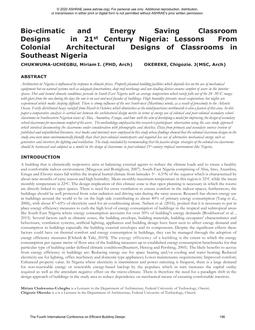Description
Architecture in Nigeria is influenced by response to climatic forces. Properly planned building facilities which depends less on the use of mechanical equipment but on natural systems such as adequate fenestrations, deep roof overhangs and sun shading devices ensures comfort of users in the interior spaces. Hot and humid climatic conditions pervade in South-East Nigeria with an average temperature which rarely falls out of the 24 -30 oC range; with glare from the sun during the day; the sun is on east and west facades of buildings. High humidity prevents sweat evaporation; hot nights are experienced which make sleeping difficult. There is strong influence of the wet South-west (Maritime) winds, as a result of proximity to the Atlantic Ocean. Fairly distributed heavy rainfall from March to October, which diminishes as the wind penetrates northwards is also a feature of this area. In this paper a comparative analysis is carried out between the architectural design merits in terms of energy use of colonial and post-colonial secondary school classrooms in Southeastern Nigerian states of Abia, Anambra, Enugu, and Imo with the aim of developing a model for improving the design of secondary school classrooms for maximum comfort of the users . The methodology employed in this research is participant- observation using the case study approach which involved documenting the classrooms under consideration with photographs and sketches. Data from primary and secondary sources (review of published and unpublished literature, text books and internet) were employed in this study whose findings showed that the colonial classroom designs in the study area were more environmentally friendly than their post-colonial counterparts and required less use of alternative mechanical energy such as generators and inverters for lighting and ventilation. The study concluded by recommending that the passive design strategies of the colonial era classrooms should be harnessed and adopted as a model in the design of classrooms in post-colonial 21st century tropical environment like Nigeria.
Citation: 4th Intl Conf: Efficient Bldg Design
Product Details
- Published:
- 2020
- Number of Pages:
- 9
- Units of Measure:
- Dual
- File Size:
- 1 file , 2.6 MB
- Product Code(s):
- D-ICEB20-24




